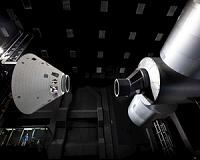 |
Houston TX (SPX) Apr 20, 2011 A rotating device developed by NASA inventors to grow better living tissue specimens was inducted into the Space Technology Hall of Fame Thursday, April 14. The Space Foundation honored the NASA team who created the device, which promises help for several diseases, during a ceremony at the 27th National Space Symposium in Colorado Springs, Colo. Developed in 1986 by a group of NASA engineers and researchers at the agency's Johnson Space Center in Houston, the device, known as the bioreactor, enables the growth of tissue, cancer tumors and virus cultures outside the body in space and on Earth. It has many advantages over typical laboratory methods. Lab-grown cell cultures tend to be small, flat and two-dimensional, unlike normal tissues in the body. However, tissues grown in the bioreactor are larger and three-dimensional, with structural and chemical characteristics similar to normal tissue. The bioreactor has no internal moving parts, which minimizes forces that might damage the delicate cell cultures. Three of the co-developers of the bioreactor also are being inducted in the Space Technology Hall of Fame: Dr. David Wolf, NASA astronaut, physician and electrical engineer; Tinh Trinh, senior mechanical engineer, Wyle Integrated Science and Engineering Group; and Ray Schwarz, chief engineer and co-founder of Synthecon Inc. The bioreactor has been used for experiments aboard the space shuttle, the Russian Mir space station and on Earth. Researchers across the United States use this technology to study cancer, stem cells, diabetes, cartilage and nerve growth, and infectious disease. Researchers at the National Institutes of Health used the methods to propagate the human immunodeficiency virus, or HIV, in artificial lymph node tissue. This research resulted in the ability to study the virus life cycle under controlled conditions outside of the human body. The bioreactor is a spinoff technology that entered the commercial world when Synthecon licensed it in 1993. Regenetech Inc. licensed 11 patents from Johnson in 2001 to produce three-dimensional tissues in the bioreactor. Regenetech, through a special NASA agreement, provides the technology to researchers pursuing rare disease treatments. In December, 2010, Emerging Healthcare Solutions Inc. acquired a sublicense from Regenetech to use the bioreactor. The bioreactor is manufactured for commercial sale by Synthecon. A closed tubular cylinder forms the bioreactor's cell culture chamber, which is filled with a liquid medium in which cells grow. The chamber rotates around a horizontal axis, allowing the cells to develop in an environment similar to the free fall of microgravity. Oxygen, required by cells for growth, is fed into the liquid medium through a porous wall in the chamber. The importance of this cell culture technique is that fluid mechanical conditions obtained in microgravity, and emulated on Earth, allow the growth of tissues in the laboratory that cannot be grown any other way. The 2011 Space Technology Hall of Fame organizational inductees are those that developed the technology and refined it for commercial use: NASA's Johnson Space Center, Regenetech Inc. and Synthecon Inc. All three are based in Houston.
Share This Article With Planet Earth
Related Links Space Technology Hall of Fame Space Tourism, Space Transport and Space Exploration News
 LockMart Commends Congressional Action On NASA Spacecraft
LockMart Commends Congressional Action On NASA SpacecraftDenver CO (SPX) Apr 19, 2011 Following months of short-term, stop-gap funding for NASA, Lockheed Martin welcomes final passage of the FY 2011 budget by the Congress, which has been sent forward for President Obama's signature. As stated by Congressional committee members, continuing the development of the Orion Multi-Purpose Crew Vehicle (MPCV) along with the heavy lift launch vehicle ensures that the United States will con ... read more |
|
| The content herein, unless otherwise known to be public domain, are Copyright 1995-2010 - SpaceDaily. AFP and UPI Wire Stories are copyright Agence France-Presse and United Press International. ESA Portal Reports are copyright European Space Agency. All NASA sourced material is public domain. Additional copyrights may apply in whole or part to other bona fide parties. Advertising does not imply endorsement,agreement or approval of any opinions, statements or information provided by SpaceDaily on any Web page published or hosted by SpaceDaily. Privacy Statement |